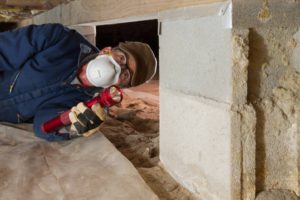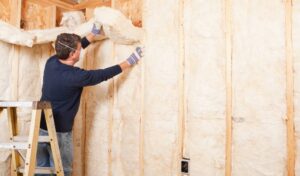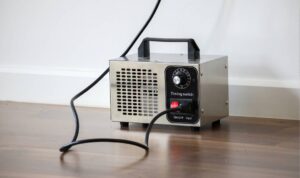Importance of addressing attic mold issues promptly
Addressing attic mold issues promptly is crucial to prevent further damage to your attic and potential health risks for your family. Mold growth in the attic can occur as a result of moisture problems, often due to poor ventilation, leaks, or inadequate insulation. If left unchecked, mold can spread and cause structural damage to the attic, including rotting wood and compromising the integrity of the roof.
Furthermore, mold in the attic can release spores into the air, which can pose health risks to your family, especially for those with respiratory issues or allergies. It’s essential to address attic mold issues promptly to ensure the safety and well-being of your household.
To identify and resolve the moisture problem in your attic, start by checking for proper ventilation and mold inspection. Ensure that soffit, ridge, or gable vents are clear and unobstructed to allow for the free flow of air. Additionally, inspect the attic for any gaps, cracks, or areas where moisture may be seeping in and seal them appropriately. Consider adding insulation to regulate moisture levels and prevent condensation. Lastly, fix any leaks in the roof or plumbing to eliminate potential sources of moisture. By taking these steps, you can effectively address attic mold issues and prevent further damage and health risks.
Understanding the basics of attic mold growth
Attic mold growth can be a common and costly issue for homeowners. Understanding the basics of how and why mold develops in attics is essential for preventing and addressing this problem. From the causes of mold growth to the signs of its presence, having a solid grasp of the fundamentals can help homeowners take the necessary steps to protect their homes and their health. In this guide, we will explore the key factors that contribute to attic mold growth and provide insights on how to identify and address this persistent issue.
Causes and Contributing Factors
Understanding the causes and contributing factors of a specific issue is crucial in addressing and finding solutions to it. Whether it’s a health condition, social problem, or environmental issue, identifying the root causes and factors that contribute to its persistence can help in developing effective interventions and prevention strategies. By examining the various elements that play a role in the development or perpetuation of an issue, we can work towards creating sustainable and long-term solutions that address the underlying issues. In this section, we will explore the causes and contributing factors of different issues, shedding light on the complexities that influence their existence and impact in our society.
Roof leaks and their impact on attic mold growth
The first step in identifying and addressing roof leaks and their impact on attic mold growth is to check for dark discoloration or staining of the wood in the attic. This could indicate a potential leak in the roof that is allowing moisture to enter the attic space. Next, observe vulnerable areas such as around vent pipes, chimneys, and flashing for potential moisture intrusion. These are common areas where roof leaks can occur. Differentiate between roof leaks and condensation by checking for signs of water staining on the ceiling and walls, as well as observing any musty odors in the attic.
If a roof leak is identified, it is crucial to address it promptly to prevent further moisture intrusion and potential mold growth. Repairing the roof and replacing any damaged insulation or wood is necessary to mitigate the impact of a leaking roof on attic mold growth. Additionally, it is important to address any underlying issues such as poor ventilation that may be contributing to condensation in the attic. Regular inspection and maintenance of the roof can help prevent roof leaks and minimize the risk of attic mold growth.
Poor ventilation: A breeding ground for mold spores
Poor ventilation in the attic can pose numerous potential dangers, with one of the most significant being the risk of mold growth. When proper airflow is lacking, moisture can accumulate in the attic, creating an ideal environment for mold spores to thrive. Additionally, temperature variance can contribute to condensation, further exacerbating moisture buildup. Mold growth not only damages the structural integrity of the attic but also poses serious health risks to those exposed to the spores.
To address poor ventilation in the attic, several steps can be taken. Ensuring proper attic insulation and sealing gaps around pipes and chimneys can help improve airflow and prevent moisture buildup. Consulting a contractor to assess insulation concerns and make necessary upgrades is also recommended.
It’s important to note that if mold growth is suspected, contacting a certified mold inspector for testing is crucial. If extensive mold is present, it’s necessary to reach out to a professional for black mold removal, as attempting to handle it without the necessary expertise can lead to further spreading and health hazards. In conclusion, addressing poor ventilation in the attic is essential to prevent mold growth and maintain a safe and healthy living environment.
Excess moisture: A catalyst for attic mold growth
Excess moisture in the attic can lead to mold growth, which can cause structural damage and health issues. To control and reduce excess moisture in the attic, proper ventilation is crucial. This can be achieved through soffit and ridge vents, gable vents, or a mechanical attic fan. Additionally, it’s important to check insulation regularly and ensure it is not trapping moisture. Any leaks in the roof or around vents should be promptly fixed to prevent water from seeping into the attic. Maintaining a consistent temperature in the attic can help reduce moisture buildup, so proper insulation is key. In some cases, using a dehumidifier in the attic may be necessary to lower humidity levels. This can be especially important in humid climates or during the summer months. By implementing these measures, homeowners can effectively control and reduce excess moisture in the attic, ultimately preventing mold growth and protecting the integrity of their home.
Identifying Mold in Attic
Mold in the attic can be a serious problem, leading to potential health issues and damage to your home. Identifying mold in the attic is essential for addressing the issue promptly and effectively. In this guide, we will discuss the signs and symptoms of attic mold, the potential causes of mold growth, and the steps you can take to identify and address the problem. Whether you’re a homeowner, renter, or property manager, knowing how to identify mold in the attic is crucial for maintaining a safe and healthy living environment.
Visible signs of mold: How to spot it in your attic
One of the most common visible signs of mold in the attic is dark stains on the plywood, which are often caused by water leaks or high humidity. Another indicator is a musty mildew smell, especially in a hot and stuffy attic. Frost buildup on the roof sheathing during winter can also be a sign of excess moisture, which can lead to mold growth. Additionally, you may notice water dripping from smoke detectors and ceiling fans, indicating a possible roof leak or condensation issue.
To visually inspect your attic for mold, look for these signs and any areas of discoloration or moisture. If you spot mold growth, it’s important to address the issue promptly to prevent further damage. This may involve fixing any leaks, improving ventilation, and possibly even hiring a professional to remove the mold safely.
Regularly checking for these visible signs of mold in your attic can help you catch and address any issues before they lead to significant damage and potential health risks.
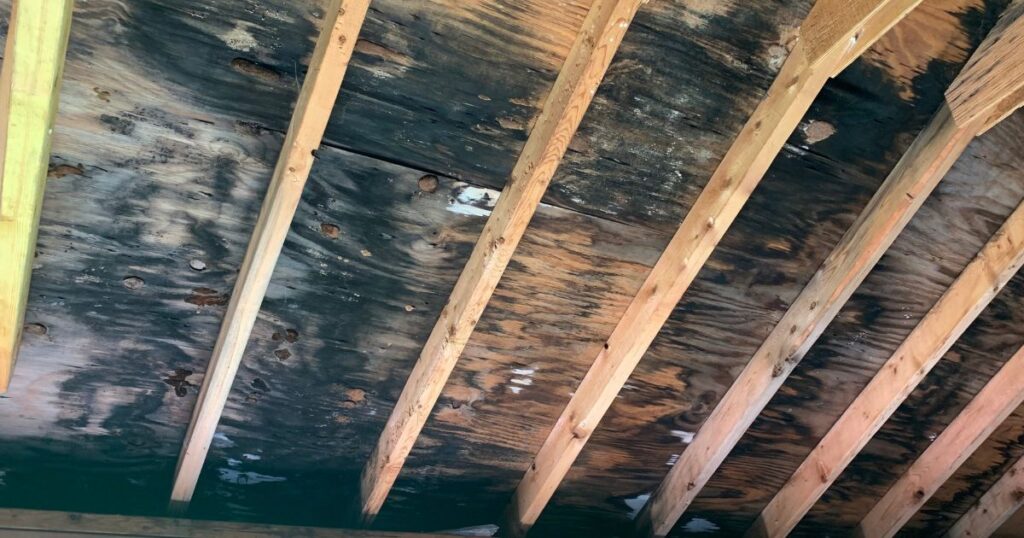
Musty smell: An indicator of potential mold presence
A musty smell in your attic is a definite indicator of potential mold presence. To inspect and identify potential mold sources in your attic, start by performing a thorough visual inspection for signs of mold or moisture. Look for dark spots or discoloration on the walls, ceiling, or insulation, as well as any visible patches of mold. Check for any areas of standing water or dampness, and address any water sources such as leaking pipes or high humidity.
If mold is present, take steps to eliminate the moisture to prevent future growth. This may involve fixing any leaks, improving ventilation, or installing a dehumidifier. After addressing the moisture issue, it’s essential to remove the mold properly and thoroughly to prevent it from returning. This may require professional mold remediation if the problem is extensive.
In conclusion, a musty smell in your attic can be a warning sign of potential mold growth. By conducting a detailed inspection and addressing any sources of moisture, you can eliminate the conditions that lead to mold and keep your attic clean and mold-free.

Health issues associated with attic mold exposure
Attic mold exposure can lead to various health issues, including allergic reactions, fungal poisoning, and mental health problems. Allergic reactions to mold can include symptoms such as sneezing, coughing, itchy eyes, and skin rashes. For some individuals, prolonged exposure to mold can lead to respiratory issues and worsen asthma symptoms.
In addition, mold exposure can also result in fungal poisoning due to the release of mycotoxins. These toxins can cause a range of symptoms, including fatigue, headaches, nausea, and even lung and respiratory issues. Prolonged exposure to mycotoxins can lead to more severe health problems over time.
Furthermore, mold exposure has been linked to mental health problems such as anxiety and depression. The presence of mold in the home can also contribute to a decrease in indoor air quality, which can further impact mental well-being.
People with compromised immune systems, such as the elderly, young children, and individuals with chronic illnesses, are especially at risk. They may experience more severe symptoms and have a harder time recovering from mold exposure. Therefore, it is crucial to address and remove mold from the attic to protect the health of those living in the home.

Effects on Indoor Air Quality
Indoor air quality can have a significant impact on our health and well-being. Poor air quality can lead to respiratory problems, allergies, and other health issues. In this section, we will explore the various factors that can affect indoor air quality and how they can impact our daily lives. We will also discuss the potential sources of indoor air pollution and how it can be measured and improved. It is important to be aware of the effects of indoor air quality in order to take necessary steps to create a healthier and more comfortable living environment.
Understanding the impact of attic mold on indoor air quality
Attic mold can have a significant impact on indoor air quality, leading to various health issues and discomfort for occupants. Mold spores released into the air can exacerbate allergies and respiratory problems, causing symptoms like sneezing, coughing, and itchy eyes. Additionally, the musty odor associated with mold can be unpleasant and can linger throughout the home, affecting overall indoor air quality.
Furthermore, exposure to attic mold can pose serious health risks. Prolonged exposure may lead to respiratory infections, asthma, and other respiratory illnesses. Additionally, mold can cause structural damage to the attic and the rest of the house if left untreated.
The HVAC system can also contribute to the spread of attic mold throughout the home, as the system can distribute mold spores to different rooms, worsening indoor air quality and potentially leading to more health issues for occupants.
In conclusion, attic mold can significantly impact indoor air quality, leading to allergies, unpleasant odors, and potential health risks. It is crucial to address attic mold promptly to prevent further spread and to safeguard the overall health and wellbeing of the occupants.
Allergic reactions and respiratory problems caused by airborne mold spores
Airborne mold spores can trigger various allergic reactions and respiratory problems in individuals. Symptoms may include sneezing, itchy eyes, chronic coughing, and irritation to mucous membranes. These reactions can be particularly severe in individuals with compromised immune systems, such as those with asthma or other respiratory conditions. Prolonged exposure to black toxic mold, specifically, can be life-threatening for these individuals.
The severity of these symptoms in individuals with compromised immune systems can be attributed to their body’s decreased ability to fight off the effects of mold exposure. For example, allergic reactions to mold can exacerbate asthma symptoms, leading to difficulty breathing, chest tightness, and wheezing. Prolonged exposure to black toxic mold can result in more severe respiratory problems and even toxic reactions, as the mycotoxins produced by this type of mold can have a direct impact on the nervous system and internal organs.
In conclusion, allergic reactions and respiratory problems caused by airborne mold spores can be particularly severe in individuals with compromised immune systems. Prolonged exposure to black toxic mold can be life-threatening, emphasizing the importance of addressing and mitigating mold issues promptly in indoor environments.
Prevention and Maintenance
Prevention and maintenance are crucial components of overall health and wellbeing. Whether it’s in the context of physical health, mental health, or maintenance of personal belongings, the importance of preventing problems before they start and consistently maintaining a healthy state cannot be overstated. In this article, we will explore the various ways in which prevention and maintenance are integral to a healthy and thriving lifestyle.
Prevention:
Prevention is the proactive approach to avoiding potential problems before they arise. In terms of physical health, this can involve measures such as regular exercise, healthy eating, and preventative healthcare screenings. When it comes to mental health, prevention may involve stress management techniques, seeking therapy, and developing healthy coping mechanisms. Additionally, prevention extends to the maintenance of personal belongings such as vehicles and appliances, where regular maintenance can prevent costly repairs or replacements in the future. Overall, prevention is about taking proactive steps to minimize the risk of problems and maintain a healthy state.
Maintenance:
Maintenance is the ongoing effort to preserve and sustain a healthy state or condition. This can involve regular upkeep and care of physical health through practices such as routine medical check-ups, medication adherence, and consistent exercise. When it comes to mental health, maintenance may involve ongoing therapy, self-care practices, and seeking support when needed. In terms of personal belongings, maintenance involves regular servicing and cleaning to ensure their optimal functioning. Ultimately, maintenance is about the ongoing effort to sustain and preserve a healthy state or condition.
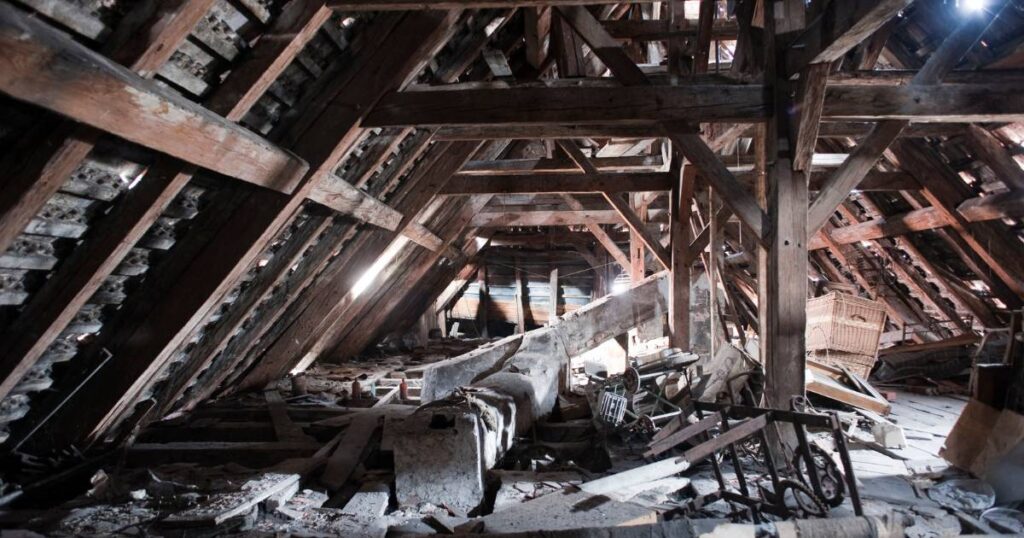
Importance of proper ventilation in preventing attic mold growth
Proper attic ventilation is crucial in preventing mold growth. Without adequate ventilation, condensation and moisture can build up in the attic, creating the perfect environment for mold to thrive. This can lead to a range of health issues and costly property damage.
To ensure proper attic ventilation, it’s important to check for any bathroom or dryer vents that may lead into the attic, and to seal up any gaps around pipes or chimneys that could allow moisture to enter. Proper insulation is also important, as it can help regulate the temperature in the attic and reduce the likelihood of condensation.
Regular inspections with a home inspector can also be beneficial in preventing mold growth. They can identify any ventilation or insulation issues that may need to be addressed to prevent moisture buildup in the attic.
In conclusion, proper attic ventilation is essential in preventing mold growth. By addressing ventilation and insulation issues, as well as conducting regular inspections, homeowners can help maintain a healthy and mold-free attic space.
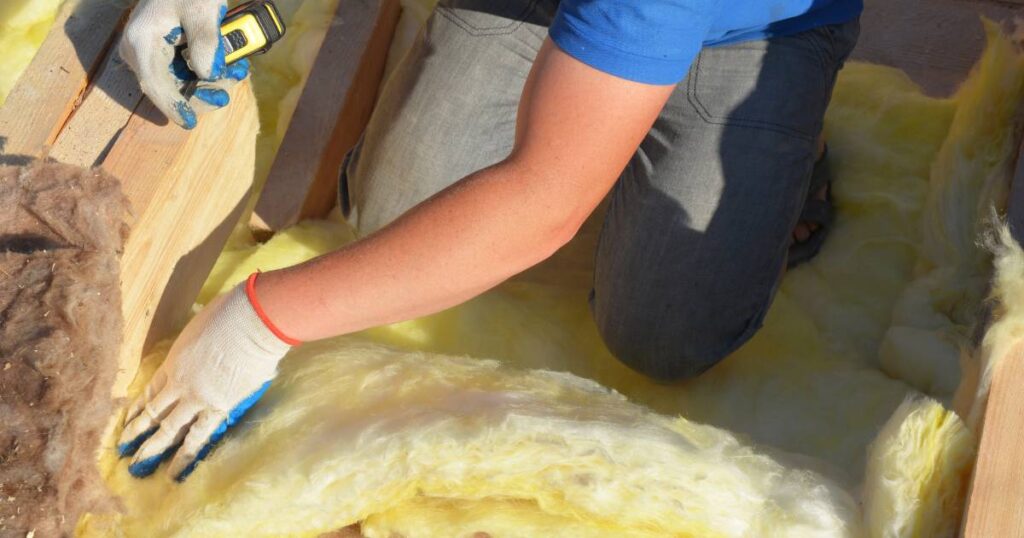
FAQ’S:
How do I know if there is mold in my attic?
There are several signs that may indicate the presence of mold in your attic. First, you may notice a musty or earthy odor in the area. This smell is often associated with mold growth and can be quite distinct. Second, you may see visible signs of mold, such as black or green patches on surfaces like walls, insulation, or wooden beams. These patches can vary in size and may be fuzzy or slimy in texture. Finally, you may experience health symptoms such as coughing, sneezing, or respiratory issues when spending time in or near the attic. If you notice any of these signs, it is important to address the issue promptly and seek professional help if needed.
Is mold in the attic dangerous?
Mold in the attic can pose potential dangers to both your health and your property. Mold releases spores into the air, which can be inhaled and cause respiratory issues, allergic reactions, and other health problems. Prolonged exposure to mold can lead to more severe health complications, especially for individuals with pre-existing respiratory conditions or weakened immune systems.
How can I prevent mold growth in my attic?
To prevent mold growth in your attic, there are several steps you can take. First and foremost, ensure that your attic has proper ventilation. This can be achieved by checking for any bathroom or dryer vents that may lead into the attic and sealing up any gaps around pipes or chimneys that could allow moisture to enter. It’s also essential to have adequate insulation in place, as this helps regulate the temperature in the attic and reduces the likelihood of condensation. Regular inspections with a home inspector can also help identify any ventilation or insulation issues that need to be addressed.
Can I remove mold from my attic by myself?
If you discover mold in your attic, it’s important to address the issue promptly and effectively to prevent further damage and potential health risks. While some minor cases of mold can be safely removed by homeowners, it is recommended to consult with a professional mold remediation specialist for larger or more extensive infestations.
Will my homeowner’s insurance cover mold remediation in the attic?
Homeowner’s insurance policies vary in coverage for mold remediation in the attic. Some policies may provide coverage if the mold growth is a result of a covered peril, such as a sudden and accidental water leak or burst pipe. However, it is important to review your specific policy and consult with your insurance provider to understand the extent of coverage and any limitations or exclusions that may apply.
How much does it typically cost to remove mold from the attic?
When it comes to the cost of mold removal in the attic, there are several factors that can influence the overall expense. The size and severity of the mold infestation will play a significant role in determining the cost. A small, localized area of mold may be less expensive to remove compared to a larger, more widespread problem.
How long does the mold removal process in the attic usually take?
The duration of the mold removal process in the attic can vary depending on the extent of the infestation and other factors. In general, smaller and localized areas of mold can be remediated more quickly compared to larger and more widespread problems. The process typically involves several steps, including identifying and addressing the source of moisture, containing the affected area to prevent further spread, removing any damaged materials, cleaning and disin fecting surfaces, and conducting post-remediation testing to ensure the mold has been effectively removed. Depending on the complexity of the situation, the process can take anywhere from a few days to several weeks. It is important to work with a professional mold remediation specialist who can provide an accurate estimate of the timeline based on your specific circumstances.

